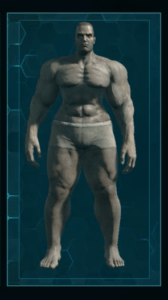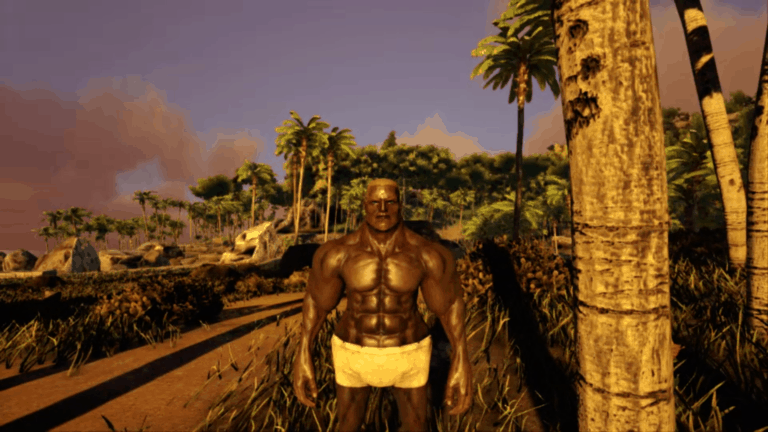ARK: Survival Evolved is an open-world sandbox survival game that can be played solo, privately with friends, or on public dedicated servers. It has an enormous die-hard fan base who have sunk thousands of hours into the game on every platform available. When a game has an army of supporters that outnumbers the North Korean military, there’s usually something awesome about it.
If you watch ARK’s advertisements and trailers, you’ll think it’s a dinosaur game. Players slaughter behemoths in gorgeous jungles under the infinite sky. They ride pet dinosaurs into a T-Rex’s lair and use spears, pistols, and machetes to take him down. They loot the corpse, whistle for their flying pterodactyl, and ride off into the prehistoric sunset.
Customize Your Game Til There’s Nothing to Play
Booting up ARK for the first time, before your toon so much as emerges from the primordial sludge, you are given the opportunity to customize anything and everything. There are hundreds of sliders, thousands of combinations, and tons of game modes. You can nuke dinosaur health and damage dealt. You can turn off hunger and thirst. You can fiddle with the length of the day and night cycle and pretend you’re in Alaska. Even the XP multiplier is adjustable.
It’s simple to apply defaults and move on, but these sliders, positioned as ARK’s opening salvo, beg a critical question: What experience did the developers intend for players of this game? What did they want players to think and feel?
Playing a new game is like going on a date. You ask out a woman because something about her charmed or titillated you. You hope you click right off the bat. Taking the time to get acquainted with her, you discover things you like and some you don’t. You hope the good outweighs the bad and that the two of you can form a relationship and have a lot of fun together.
ARK is like ordering a silicone sex doll. Design her yourself. Choose her bust size, waist measurement, skin color, and hair color. She doesn’t come with a personality. The amount of fun you have with her depends on your imagination! You’ll get out of her exactly what you put in, so to speak.
Should you have the patience to get past ARK’s initial wall of menus, you’ll create a character—an ugly, misshapen hunk of meat. No matter how you drag the sliders, your body will be badly proportioned and your skin shaded with the pallor of death. To save yourself endless minutes trying to make your toon look human, you’ll hit the “randomize attributes” button. ARK’s randomized avatars are worthy of a Faces-of-Meth-style gallery. These twisted, gnarled, broken caricatures of neanderthals are amusing, but nobody would invite them to a party.

It’s crazy easy to inadvertently delete your hideous avatar and replace him with a new one. Accidentally clicking one of the various save buttons on the busy character creation interface is such a common occurrence that there are dozens of online posts from people who deleted a toon into which they’d poured hundreds of hours. Problems such as this are so basic that you wonder if a single employee at Studio Wildcard had software development experience before working on ARK. Then you wonder if a single employee ever played a game from another developer. Gamers will tolerate a poor user experience, but ARK is at least a full decade behind the polished AAA titles it’s priced to compete with, and years behind even free-to-play titles.
How Much Fun Is Surviving?
Finally your hairy 35-year-old golem spawns in the game world. And lo, it is a harsh and unforgiving land. From the outset of the game it’s clear that the developers want survival to be the raison d’etre of playing ARK.
Across the top of the screen you’ll see a red notification that says your character is cold. He’s also shitting loudly, leaving behind fat little piles of turds. (Don’t worry, you can turn off excrement in the settings.) Of course he’s hungry and thirsty. Address these problems or die. Make clothes or a fire to warm up. Refill your thirst and hunger bars. Survive. It’s a survival game.
In the beginning, players are expected to engage in primitive accumulation of food, water, and shelter. As they continue to play, they use the game’s character progression system to build ‘technology,’ which ostensibly eases the burden of survival. As an ARK player, I constantly have my bodily needs in mind. I am either addressing them directly, or I am designing my universe so that my needs might be more easily met in the future.
Here’s where I have to pause. Is looking after an online avatar as if it were a Tamagotchi a task that we, as gamers, enjoy? Survival games force you play and interact with the game simply to go on playing the game. They’re like paying rent to continue living in your apartment. But in real life, a single hard-boiled egg will give you enough food and energy for live and work comfortably for a few hours. In ARK, you have to acquire food every few minutes.
Because survival games continue to be a popular genre, and some are even well-liked, I couldn’t condemn ARK on the survival aspect alone. I decided to try playing with the thirst, hunger, and other bodily discomfort bars turned off. Suddenly, there was no reason to make a shelter. There was no reason to learn to build a campfire or to cook or harvest raw meat. Playing without the survival bars felt like using a powerful cheat code—it removed large portions of the game. I realized that the acquisition of food might somehow be the most interesting part of ARK, and that touching any of the sliders has the potential to destroy the sandbox, rendering much of it inoperative and throwing off all semblance of balance and fair gameplay.
Next I lowered the amount of damage the dinosaurs do. It created a glitchy world where the dinosaurs chased each other, nipping at the heels of anything they saw until they were killed. This revealed that NPC behavior in ARK doesn’t follow any particular set of rules, and it confirmed that ARK’s game world doesn’t adapt to the settings you can change. Gamers enjoy choice and customization, but the game ought to work properly inside at least most of the parameters that users can define.
A Progression System that’s Irritating for Group Play
Assuming you carve out a meager existence somewhere in ARK’s grim universe, you’ll arrive at the meat and potatoes of the game: your toon’s progression. In ARK all actions—from simple harvesting of rocks and berries to killing creatures and crafting items—provide XP. This generous, egalitarian leveling system was the first aspect of the game that struck me as pleasant.
When you level up, you are able to improve a basic stat point (such as health, carry capacity, or the rate at which you go hungry), and you receive a point to place in ‘Engrams.’ The Engram system consists of about 100 levels of crafting recipes. At each level you choose from several weapons, articles of clothing, gadgets, health products, building supplies, etc.
If two or more people are playing together, they can ‘plan’ their Engram purchases intelligently so that neither spends a point an a duplicate Engram. If I purchase the spear Engram, for example, I can craft a spear for myself and for Genevieve. She shouldn’t purchase the spear but rather the bow or any other Engram available at the spear’s level. Using this method players can craft a wider range of items together than either could solo.
It sounds like a nice system that encourages cooperative play, but every time we engaged with the game’s crafting and progression system it chained us like prisoners and reduced us to misers. When I absent-mindedly glanced at Genevieve’s screen and saw her purchase a bow and arrow, I didn’t have the heart to tell her that she wasted a ton of points on an Engram I already owned. I realized that playing together, neither of could complete our banal, obligatory level-up tasks or mess around with our toons without consulting the other. I vowed to complete all our level-ups together, which caused new tension and disappointment. When I purchased a cool slingshot, Genevieve had to buy a wooden foundation. It’s a poorly conceived system that punishes players for innocently engaging with the game and encourages a kind of toxic codependency: one player crafts all the weapons, and the other crafts all the clothes.
A Lonely Death in a Ditch
At first, I was delighted with the way ARK handles player death. When you die, your items and all crafted armor and weapons drop in a little rucksack. You respawn in a random location, usually relatively close to where you died. You can return and collect the rucksack, resuming play without losing anything. You could die a hundred times and your character progress would be saved as if you had been successful in your endeavor and simply leveled up and gained experience. The world of ARK may be merciless, I thought, but with such a light penalty for death, I could continue playing.
In fact, dying in ARK can be even more frustrating than dying during a long, difficult, drawn-out boss fight when the boss only has a shred of remaining health. ARK won’t hesitate to kill your toon a dozen times in quick succession. Lack of a formal penalty doesn’t alleviate the annoyance and feeling of loss. More important, some deaths are uniquely brutal and completely unavoidable.
One particular death caused me to put down my controller. Allow me to set the scene. Genevieve and I had spent a few hours building a hut on the beach. We added a few storage boxes, but their interface was so clumsy and overwrought that we decided harvesting materials when you need them would always be more efficient than storing them. Neither of us were sure what else to do with the structure. With the survival bars turned off, our casa bonita was a stupid, pointless thing.
I wandered out into the world, where my toon became poisoned. Using the game’s menus I attempted to learn how to cure myself. If the answer was there, I never found it. I died alone in a rotten hole.
At the time of my death, Genevieve was miles away in our shack. The game kicked me back to the shack, and then, due to the bizarre way that players are tethered to the host in a hosted game, Genevieve was teleported to a random location on the map. I couldn’t find an indicator of where my loot had dropped. We ventured alone into the woods to search for my gear. Night fell. In pitch black, herds of little dinosaurs beset us. We perished. All was lost.
At any given moment in ARK, it’s possible to put yourself in an ugly situation with no escape. The real world is just like that! ARK is a survival game! If Genevieve and I found ourselves naked in the woods surrounded by dinosaurs after dark we would die the same way. We’d scramble around. It’d be hard to see. Something would block the way. One of us would get hurt. We’d die. To this I say that I would do a better job keeping us alive and find more levity, warmth, drive, and joy in the real-life scenario of dying in the woods with my wife than I did in the virtual world of ARK.
The Combat Sucks
So far I’ve explained that ARK is a bitter, confusing, and poorly-designed mess of a game. One thing that a gamer might do is play a bitter, confusing, and poorly-designed mess of a game if there’s exciting combat. This is where ARK most spectacularly fails.
If you played an early MMORPG like Everquest or Dark Age of Camelot, then you have a perfect idea of what combat in ARK is like. Mobs patrol their little plot until they find something to aggro. Once aggroed, they mindlessly follow their target and auto-attack until they or their target dies. Pretty simple, and easy to program.
In ARK, mobs chase and auto-attack. You are able to move and attack, either with your fists or a weapon. That’s all, folks! The biggest challenge is aiming your ranged weapon or keeping distance on an aggroed dinosaur. Failure or success usually depends entirely on the random power level of the beast you’re fighting. This is bad design, no matter how you slice it. Compare it to Monster Hunter: World where the monsters interact with each other and the environment, get worn down over time, have pieces broken off, and exhibit complex combat patterns depending on their level of excitement or damage taken. Even those early MMOs gave your character skills and abilities that you could use to influence the battle. As a first-person combat game, the early MS DOS version of Doom had far more interesting, complex, and challenging combat than ARK.
Like ARK’s other shortcomings, the problem seems to stem from the lack of a vision or philosophy for player experience. There was no effort put into the design of ARK’s ‘combat system,’ but how important is combat if players are meant to spend the majority of their time surviving? Or building? We’ll never quite know how players are meant to enjoy ARK.
But I Heard You can Tame Dinosaurs?
All while the eternal stick of death and starvation is beating your toon, you crave a positive interaction with a dinosaur. You want to tame him! Be his friend . . .
I admit that I did want to tame a dinosaur. Probably most people who buy ARK would say that’s the one thing they want to do. The taming system was the final straw, the thing that made us uninstall the game. Taming a dinosaur consists of endless instances of feeding. Taming, like combat, requires you to press a button over and over until some arbitrary (adjustable!) number is crossed, and then the interaction is over and the dinosaur is converted to your pet. In other words, taming a dinosaur in ARK is as fun and engaging as manually validating data by clicking cells in a spreadsheet. You’re looking at a minimum of thirty minutes of this mind-numbing interaction to complete the taming process. In the case of a larger creature, it could take up to nine hours.
If somebody had told me that it takes nine real-life, sitting-in-front-of-your-TV, button-clicking hours to tame a T-Rex, I would have laughed. Nine straight hours of playing any other game would get you sweet legendary loot, massive character upgrades, and as much diverse play as you could queue into. You can beat a lot of games in nine hours. Nine straight hours of watching The Office would get you past season one all the way into Michael buying a condo.
Let’s compare again to Monster Hunter. In Monster Hunter, you’re asked to overcome the will and determination of a massive, awe-inspiring, fire-breathing giant with nothing more than a sword. The monsters are usually the size of a whale or small apartment building. They fight for their lives, and they don’t like you. Monster Hunter delivers on the ambitious premise of capturing a wild animal: a monster capture is a dangerous, heart-rending process where players wound and brutalize the creature until it retreats to its lair, so exhausted that it falls unconscious, still breathing, but only barely. When the monster finally collapses, you regret destroying such a beautiful animal. In ARK, accomplishing a similar goal requires nothing but building a pen around him and interacting with a certain menu a predetermined number of times. Why is taming ARK’s dinosaurs so banal and unrealistic if the rest of the game is so rah-rah realism that you’re literally pooping?
In ARK, everything that’s difficult for developers and important to players was done the quick and lazy way. Everything that’s easy for developers and doesn’t matter to players is robust and well-developed. Why should we waste our time playing a game like that?
Not Recommended






